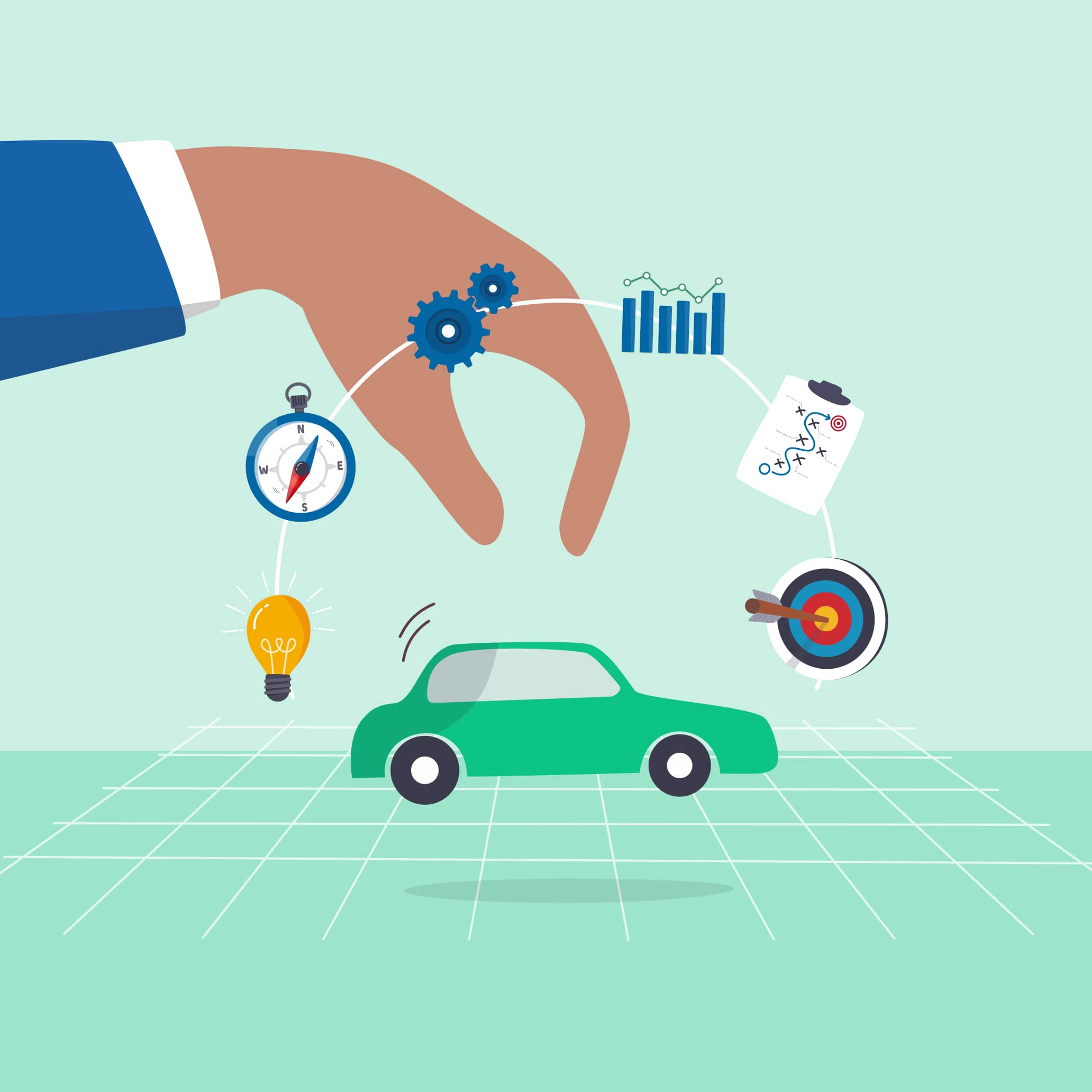

TABLE OF CONTENTS
In charge of designing parking at a new development? Read on to learn:
Accessing parking is one of the foundational elements for a development in the United States. Depending on the parking requirements of the local jurisdiction, well-designed parking will be essential to making sure the development operates as it was intended to.
Bad parking design can easily lead to a stressful situation for people trying to park their cars or simply navigate out of the parking area. It can also lead to situations where the parking doesn’t work for the development it was built for.
Good parking design, on the other hand, works for all the users of the parking lot, from pedestrians navigating to and from their cars to people driving around looking for a spot in their respective cars.
Depending on the building’s use, the parking design will vary. Residential parking design, for example, might look very different from the parking design for a commercial big box store or restaurant. Mixed-use developments provide an interesting intersection of parking uses, allowing for some interesting designs to be implemented.
On top of the differences between parking for various uses, each site will have its own specific design needs. As you’re designing your parking, you will likely have to adjust a garage or lot to the needs of your site and the building it will serve, as well as any other constraints you are working with.
First, let’s talk about some basic parking design principles.
Getting a good grasp of the basics are integral to designing a functional parking area, allowing traffic to flow effectively while also fitting in as many parking spaces as possible.
Above all, designing a parking area is all about fitting in the most parking spaces for the least amount of money. As Elaine Uang, an architect that works on multifamily housing in California, points out, “parking is a geometry puzzle that is unique to every development.”
Elements such as 90-degree spaces and double-loaded drive aisles allow you to fit in the most spaces and fulfill the parking requirements of the local jurisdiction at the same time, making efficiency the design element that informs all other decisions."
Parking is even more important when you consider the implications for the development as a whole: “Often you have to figure out how to fit in cars first, and then plan the design of the building.” Ms. Uang explains, detailing how the size of the parking area will influence the dimensions of the building.
Here are a few of the most important principles when designing a parking area:
Residential parking areas are intended for long-term use for tenants. This makes efficient space usage and security even more critical for your parking area.
For a parking lot design in residential, most architects gravitate toward 90-degree spaces and a rectangular parking lot design. This allows you to fit the most spaces into the smallest area. You’ll also want to properly mark each spot so that people know which space is theirs. EV infrastructure should ideally also be provided, especially if you expect many tenants to have electric cars.
At a minimum, at least think through the EV infrastructure and where chargers (and required conduit) will eventually go.
A designer should also consider what types of cars will be kept in the residential lot or parking garage. Many cars in the United States are larger, making it difficult to park in smaller spaces. A residential development that wants to rent out space to their tenants may miss out on possible revenue — or even apartment leases — if they can’t effectively use all their spaces.
In fact, a recent development had this very problem, and were forced to remove several of their spaces because of parking conditions that were too tight. This led to a loss in revenue that could have been avoided with better parking design.
All spots in red, after construction, were pulled from use to give that space over to the spots on either side:

Commercial parking design stresses efficiency and convenience over long-term parking use. For added convenience, architects more frequently used angled spaces in commercial applications.
That’s because angled spaces at 45 to 60 degrees allow for faster and easier egress in and out of the spot. People can pull in and out fairly quickly without the added stress of navigating a packed parking lot with 90 degree spaces. When designing 45 to 60 degree parking lots, you will want to use one-way aisles.
Because commercial parking lots have a lot of constant traffic, safety is also a major concern. You’ll want to avoid possible collisions with proper signage and infrastructure that supports pedestrian safety. This could translate into a sidewalk in between aisles or an area labeled as a pedestrian walkway that allows people to safely navigate a lot.
For commercial uses such as home improvement stores, larger aisles and spaces should be considered due to the higher number of trucks that will be using the parking area.
Office parking design will depend largely on how the employees are getting to work. If you are building a car-oriented office building, enough parking for the amount of employees working out of the office will be vital.
Office parking lots typically utilize 90-degree spots — in part because most spots see cars pulling in and out twice per day. So egress is less important, and developers prioritize fitting as many cars as possible.
One solution for office parking is unbundled parking — meaning drivers pay to park — allowing developers to reduce the number of parking spaces and make their design challenge easier. Taking payments for parking also allows developers to better rationalize sharing parking between neighboring uses.
Charging for parking allows you to reduce parking need, as workers who don’t need to drive will make alternative transportation arrangements. Working with surrounding parking lots and garages to work out a shared parking plan will, in turn, reduce your parking burden even more.
An office development parking area will prioritize safe, secure parking for long-term periods. Because there won’t be as much in and out as commercial parking, less care needs to be given to convenience and pedestrian access. Typically, there will be only a few points of access to the office building, making that a simpler design element to the overall parking design. Pedestrian safety, of course, will still be important.
Parking design for mixed-use lots provides an interesting problem to solve. Your parking area has to meet the needs of multiple user groups, who have different parking needs that may conflict at times.
Office and commercial uses can often complement each other. Spaces used by employees during the day can be used for restaurants, theaters, and events at night. Many mixed-use projects have been able to save money this way, such as $1 million slashed off the Runway at Playa Vista development in Los Angeles, CA.
The US Air Force, not exactly an organization known for pushing the creative envelope on real estate development, leverages shared parking at places like Tyndall AFB to drastically cut down on the parking they needed to build.

In the case that a mixed-use development outgrows a surface parking lot, an architect can get creative with a podium garage by incorporating it into the building’s design. For example, you can make the garage’s entire first floor retail, allowing for a more pleasing facade while you put the actual parking under or over it.
There are even more creative solutions possible, such as implementing more architectural elements or amenities such as gardens and other usable spaces. For example, one parking garage built a soccer field on its top level, allowing the garage to become integral to the ways people can use the development.
There are many other design characteristics to consider in a parking lot, including drainage, lighting, and pedestrian access. Elements such as landscaping will improve the parking area’s aesthetic qualities, while good lighting will ensure easy navigation and safety in your parking lot.
Pedestrian safety and access is very important for parking areas. Here are some important elements:
During the design of the development, you have a valuable opportunity to create a better and more efficient parking experience for those who will use your building in the future. With a clear parking strategy and a vision of the development’s role in its greater area, you’ll have the freedom to design a parking lot that works for everyone involved, from the tenants of the building to the community as a whole.
On top of efficiency and functionality, great parking design can be an opportunity to expand the development’s impact, allowing it to serve many groups of people while also providing the type of parking your development needs to flourish.
When building a parking lot or reassessing how you manage existing parking, there are many solutions to consider. Unbundled parking, for example, can be difficult to allocate and manage with spreadsheets alone.
Technology solutions such as Parkade help you figure out the appropriate price and rental agreement for your parking spots, and take all parking assignments, reservations, customer service, enforcement and payment needs off the shoulders of the on-site management team.

We’re thrilled to announce one of our most significant leaps forward this year: the launch of dynamic maps across our mobile and web applications.
Read Story
Now that AB 1317 is official, it’s time to brush up on the requirements and see how your properties stand to benefit.
Read Story
For multi-family communities still offering first-come, first-served parking for residents, Southwest's decision may shed some light on why it's time for a switch.
Read Story